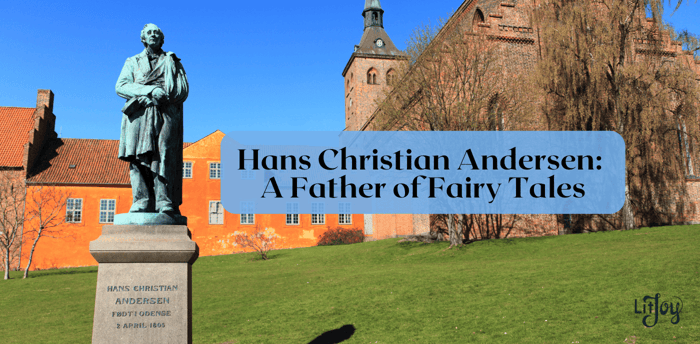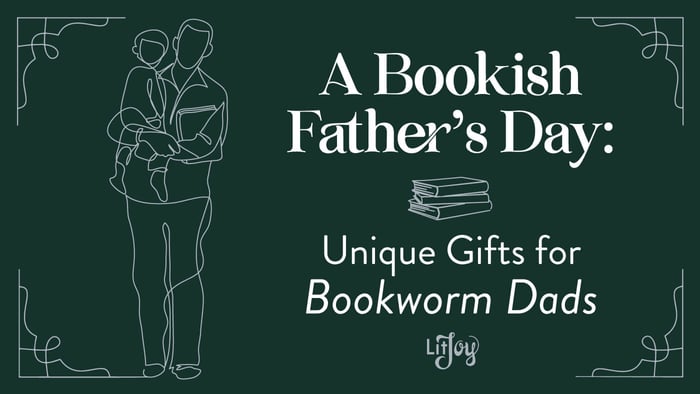
Hans Christian Andersen: A Father of Fairy Tales
Once upon a time, in a faraway land, a beloved Danish author of fairy tales named Hans Christian Andersen was born. On April 2, 1805, in Odense, Denmark, Andersen's own fairy tale story began.
In honor of his special day, let's take a look at some of our favorite tales and why they continue to enchant readers today. Grab a cup of tea and settle in for a journey through the magical world of Hans Christian Andersen.
Take the Quiz: Your life is a retelling of which fairy tale?
The Man Behind the Magic: Who Is Hans Christian Andersen?
 |
Andersen's life was a bit of a fairy tale in its own right. Born into stark poverty to a cobbler (shoemaker) and a washerwoman, Andersen's family did not having enough money to send him to grammar school. However, in his autobiography The Fairy Tale of My Life, he recounts that despite the lack of money, his parents still cultivated his imagination with stories from One Thousand and One Nights and other books found on a crowded bookshelf in their single-room home. |
Andersen spent much of his childhood creating costumes for puppets and spinning tales for entertainment. Despite his humble beginnings, his stories enchanted many readers, and he became one of the most celebrated authors of his time.
Fairy Tale Frenzy
| Hans Christian Andersen's fairy tales brought a new level of sophistication and complexity to the fairy tale genre, veering from the traditional stories and popular tales of the 19th century that had been passed down. |  |
Andersen’s beloved stories are anything but predictable and have captured the imagination of readers for generations. Featuring unconventional protagonists, like a tin soldier or a mermaid, who must navigate a world that doesn't always understand them, his stories include moral lessons for children (and adults who read them) about the importance of kindness, honesty, and perseverance.
The Timeless Appeal of Andersen's Fairy Tales
Hans Christian Andersen's famous stories feature important life lessons that stand the test of time. His enduring popularity also comes from the countless adaptations that have been created over the years. Andersen's stories have been adapted for film and television, as well as into stage productions, musicals, and even video games.
Movies Based on Hans Christian Andersen Stories
We bet that even if you've never read one of his original stories, you've encountered many of his characters in some form or another. From Disney's iconic Frozen, loosely based on “The Snow Queen,” to the recent live-action adaptation of “The Little Mermaid,” Andersen's tales continue to inspire new interpretations and adaptations.
 |
 |
What Books Did Hans Christian Andersen Write: Our Favorites
"The Princess and the Pea" (1835)
 |
One of Hans Christian Andersen’s first fairy tales is the charming and whimsical story called "The Princess and the Pea." The beloved story features a determined prince searching to marry a princess of true royal birth and a sensitive “princess” who seeks shelter at the castle one stormy night. Hilarity ensues as she “proves” she is a real princess when she says that she felt the pea while on top of the mattresses. Andersen leaves the story open-ended to allow readers to decide if the princess is really who she says she is. |
"Thumbelina" (1835)
| "Thumbelina" is beloved for its magical and imaginative world, as well as Andersen's skillful storytelling and vivid imagery. The story follows the journey of a tiny girl who overcomes various challenges, including being kidnapped by a toad and nearly forced into marriage with a mole, before finally finding happiness with a fairy prince. Along the way, she learns important lessons about trusting others, staying true to herself, and following her dreams. |  |
"The Emperor’s New Clothes" (1837)
 |
In "The Emperor's New Clothes" by Hans Christian Andersen, an emperor is so obsessed with his appearance that he falls for the ultimate fashion scam: non-existent clothes woven with lavish compliments by the “dressmakers.” It takes a brave child to point out the obvious truth, revealing that sometimes, even the most powerful people can be blinded by their own vanity. "The Emperor's New Clothes" reminds us that true confidence comes from within, and that honesty is always the best policy. The story serves as a cautionary tale about the consequences of valuing appearances over substance. |
"The Little Mermaid" (1837)
|
Given that Disney’s live-action Little Mermaid is set to release in a few short months, it is safe to say that Andersen’s "The Little Mermaid" is a timeless classic. Of course, in the original version, the mermaid doesn't end up with the prince and dies of a broken heart. Despite its tragic ending, readers love Andersen’s vivid and imaginative storytelling that explores complex emotions and relationships. "The Little Mermaid's" powerful message about the nature of true love, self-sacrifice, and the consequences of one's actions has inspired many adaptations. |
 |
"The Steadfast Tin Soldier" (1838)
 |
"The Steadfast Tin Soldier" is a tale following a one-legged tin soldier who falls in love with a paper ballerina. The soldier embarks on a challenging journey to be with her, remaining steadfast in his love. Filled with magical toys, mischievous creatures, and breathtaking landscapes, "The Steadfast Tin Soldier" by Hans Christian Andersen sends a message of love, courage, and perseverance in the face of adversity. |
"The Ugly Duckling" (1843)
|
Andersen’s "The Ugly Duckling" tells the story of a "duckling" shunned by others because of its perceived ugliness. The "duckling" eventually transforms into a beautiful swan discovering its true identity and self-worth in the process. This message of embracing one's individuality and finding inner beauty resonates with readers of all ages. Because of its powerful message of self-acceptance and the transformative power of love, "The Ugly Duckling" remains a cherished story today. |
 |
"The Snow Queen" (1844)
 |
"The Snow Queen" by Hans Christian Andersen tells a chilling tale of two friends, Gerda and Kai. Gerda sets out to rescue Kai from the clutches of the Snow Queen, an icy and malevolent figure. Along the way, Gerda faces a series of obstacles that test her courage, loyalty, and purity of heart, while Kai becomes increasingly cold and distant under the spell of the Snow Queen's enchantment. The Snow Queen represents the forces of darkness and temptation, luring Kai away from his innocence and corrupting him with her icy magic. Her appearance is cold and otherworldly, and her presence casts a cold and foreboding atmosphere over the story. |
To Be Continued...
Hans Christian Andersen Fairy Tales present important life lessons and remind us about the importance of imagination and the power of a good story. They speak to the universal themes of love, friendship, and the search for identity.
We’re sure they’ll be around for another 100 years or so. So happy birthday, Hans Christian Andersen, and thank you for bringing a little bit of magic into our lives. Here's to another year of enchanting readers young and old!


